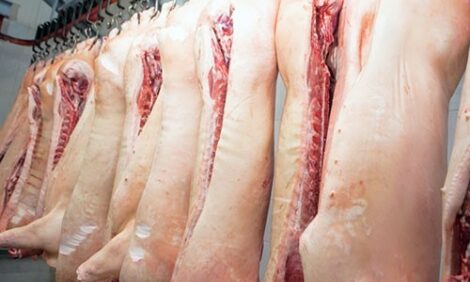



Pork producers face a vulnerable year
US - There is some bad news and some good news for pork producers this year, says Chris Hurt in his Weekly outlook report. The bad news is that pork supplies have been larger than anticipated and feed prices are causing costs of production to surge. The good news, however, is that hog prices so far have been higher than anticipated.
 Chris Hurt
Chris HurtExtension Economist Purdue University |
The second bad news component is costs of production. By the end of February, March corn futures had increased over $.50 per bushel and March soybean meal futures by about $35 per ton since the start of the year. The combined impact raised costs of production by about $4 per live hundredweight, to an estimated $45 to $46.
Thank goodness for some good news! So far this year, hog prices have had an impressive start by averaging near $42 on a liveweight basis for 51-52 percent lean carcasses. These prices are 20 percent higher than during the same period last year. At the end of February, prices were about $45, which is very close to estimated costs of production.
The source of the higher prices appears to be large pork exports driven by restrictions on both beef and poultry exports during most of February. The uncertainty of whether pork exports will continue their frantic pace is tied to agreements to reopen foreign markets to beef and poultry. Progress is being made on both. It appears that a Canada/Mexico agreement may soon be forthcoming, with Japan and South Korea perhaps to follow later this spring or summer. The avian influenza cases in the U.S. seem to be under better control in recent weeks and may soon allow reopening of many markets. If so, these will both be negative factors for pork exports and pork prices.
So what is the update on income prospects for pork producers after two months of the year have passed? Unfortunately, hog prices are not expected to cover costs of production this year. It now appears that costs will exceed $46 this summer and drop to only $43 this fall. Hog prices, on the other hand, will likely reach the mid-to-higher $40s in the spring and early summer, but fall back to near $40 in the fall. For the entire year of 2004, current projections are for hog prices to average near $43, but for costs to average about $45.50, resulting in prospects for an average loss of $2.50 per live hundredweight.
What are some key strategies for producers? Unfortunately, the U.S. industry must downsize, for two reasons. First is the continued growth of the Canadian herd, as they extract more of the North American share (24 percent more sows in the last five years). Second is the higher cost structure. In the past, high cost years have resulted in a downsizing of the herd and a return to profits in the year following the high cost year.
As has been suggesting for several months, producers need to have a feed ingredient plan in place. Old crop soybean supplies may not be rationed yet and prices of meal could still be higher, at least this spring and summer. The corn situation has now become one of anticipated tight stocks not only for the remainder of this marketing year, but continuing into 2004/05. Corn prices could also be much higher for the 2004 crop if use continues to grow or if weather disrupts a normal growing season in the U.S. Finally, the pace of pork exports is not expected to remain as favorable into the summer and fall. Some forward pricing of lean hogs with current recovering futures seems to be a reasonable consideration.
In summary, pork producers have much to be concerned about with the growing potential for even higher feed prices, with growing imports from Canada, and with the potential to reduce pork exports with the opening of beef and poultry export markets. Pork producers may want to use price risk management opportunities to come as close to breakeven as possible for 2004 and await the prospects of a better 2005 once the U.S. herd is reduced. The alternative is the rising potential for catastrophic financial consequences if U.S. weather should be adverse for 2004 crops

Source: FarmDoc - 2nd March 2004








